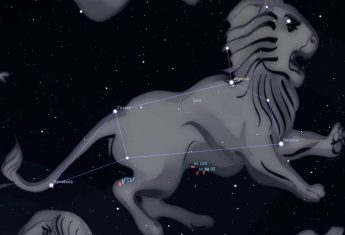This Week’s Sky at a Glance, 2024 March 9 – March 16
This Week’s Sky at a Glance, 2024 March 9 – March 16
I regard Leo the Lion as the signature constellation of spring, and it is not difficult to picture a lion in its distinctive pair of asterisms. A backwards question mark or a sickle represents its chest and mane, anchored by the bright star Regulus at its heart or front leg. To the east a triangle of stars forms the back leg and tail. Originally, a faint naked-eye cluster of stars represented a tuft at the end of the tail, but that now makes the tresses of the constellation Coma Berenices.
In mythology the lion was a vicious creature that resided in the mountains of Nemea. Its hide was impenetrable to spears or arrows; the only thing sharp enough to penetrate the lion’s hide was its claws. The first of Hercules’s twelve labours was to kill this creature, which the legendary strongman did by strangulation. He then used the claws to cut off the lion’s hide for use as a shield. A friend of mine sees this constellation as a mouse, with the triangle as its head and the sickle as its tail. However, legends are not made by having a muscular demigod battle a mouse.
Amateur astronomers often point their telescopes at Leo for two trios of galaxies; one under the belly and the other by the back leg. Each trio can fit within the view through a wide-field telescope eyepiece. Five of the six galaxies are listed in the Messier catalogue of fuzzy objects that could be mistaken for comets.
This Week in the Solar System
Saturday’s sunrise in Moncton is at 6:42 and sunset will occur at 6:17, giving 11 hours, 35 minutes of daylight (6:46 and 6:22 in Saint John). Next Saturday the Sun will rise at 7:28 and set at 7:27, giving 11 hours, 59 minutes of daylight (7:33 and 7:32 in Saint John). Daylight Time begins at 2:00 am this Sunday, moving timepieces ahead one hour and causing grumpiness in the morning for a few days.
The Moon is new and at perigee this Sunday morning, resulting in extreme tides early in the week. On Monday the slim crescent appears a fist-width above and slightly left of Mercury. It passes Jupiter Wednesday and sits below the Pleiades star cluster on Thursday. The steep angle of the ecliptic places Mercury higher in the sky for better viewing over the month. On Thursday a telescope might reveal Jupiter’s moon Ganymede passing behind the planet at 9:04. The shallow angle of the ecliptic in the morning sky makes it very difficult to see Mars, Venus and Saturn in bright twilight.
The Fredericton Astronomy Club meets in the UNB Forestry-Earth Sciences building at 7 pm on Tuesday. On Sunday evening at 8 pm, tune in to the Sunday Night Astronomy Show via the Facebook page or YouTube channel of Astronomy by the Bay.

